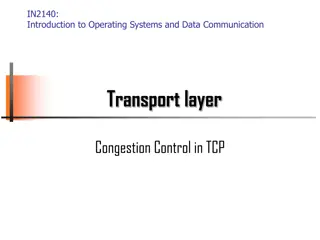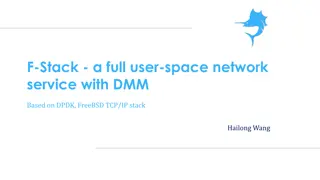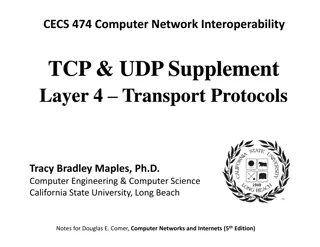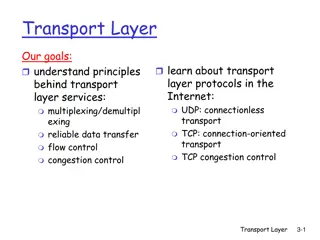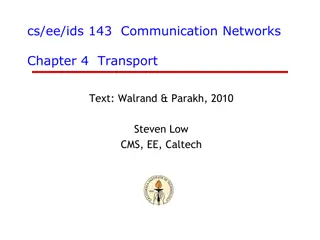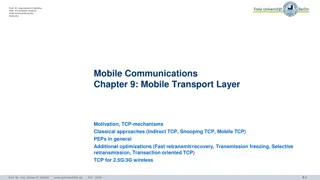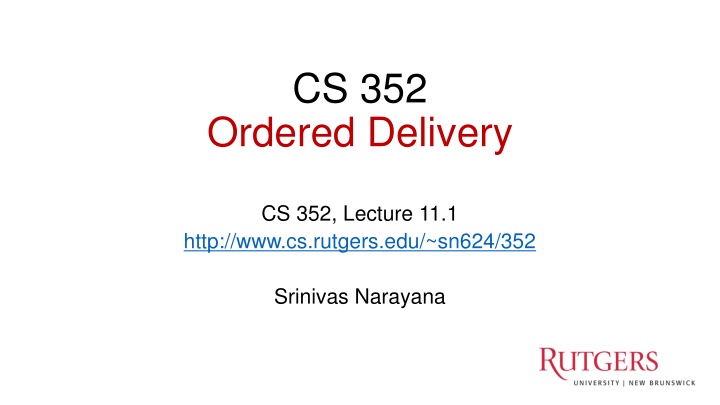
Transport Layer Protocols in Computer Networking
Explore the role of transport layer protocols like TCP and UDP in ensuring reliable and ordered packet delivery, handling reordering at the receiver side, and the interaction between applications and TCP for seamless data transmission over networks.
Download Presentation

Please find below an Image/Link to download the presentation.
The content on the website is provided AS IS for your information and personal use only. It may not be sold, licensed, or shared on other websites without obtaining consent from the author. If you encounter any issues during the download, it is possible that the publisher has removed the file from their server.
You are allowed to download the files provided on this website for personal or commercial use, subject to the condition that they are used lawfully. All files are the property of their respective owners.
The content on the website is provided AS IS for your information and personal use only. It may not be sold, licensed, or shared on other websites without obtaining consent from the author.
E N D
Presentation Transcript
CS 352 Ordered Delivery CS 352, Lecture 11.1 http://www.cs.rutgers.edu/~sn624/352 Srinivas Narayana 1
Transport Application FTP HTTP HTTPS SMTP DNS Transport UDP TCP IP Network X.25 802.11 ATM Host-to-Net
Modularity through layering Apps: useful user-level functions HTTP FTP NV TFTP TCP UDP Transport: provide guarantees to apps IP Network: best-effort global pkt delivery Ether ATM WiFi Link: best-effort local pkt delivery
How do apps get perf guarantees? The network core provides no guarantees on packet delivery Transport software on the endpoint oversees implementing guarantees on top of a best-effort network Three important kinds of guarantees Reliability Ordered delivery Resource sharing in the network core Transmission Control Protocol (TCP)
Reordering packets at the receiver side Receiver Sender Let s suppose receiver gets packets 1, 2, and 4, but not 3 (dropped) 1 2 3 4 Suppose you re trying to download a Word document containing a report 1 2 4 What would happen if transport at the receiver directly presents packets 1, 2, and 4 to the Word application? 5
Reordering at the receiver side Receiver Sender Reordering can happen for a few reasons: Drops Packets taking different paths through a network Receiver needs a general strategy to ensure that data is presented to the application in the same order that the sender side pushed it Receiver uses two mechanisms: Sequence numbers Receiver socket buffer We ve already seen the use of both of these for reliability 1 2 3 4 1 2 4 5 3
Interaction between apps and TCP Sender deposits data in receiver socket buffer application process recv() TCP socket receiver buffers An app with a TCP socket reads from the TCP receive socket buffer e.g., when you do data = sock.recv() TCP code TCP receiver software only releases this data to the application if the data is in order relative to all other data already read by the application from sender receiver protocol stack This process is called TCP reassembly
TCP Reassembly Sender/Net writes here Application can read up to here 1 2 1 4 2 1 4 2 3 Socket buffer memory on the receiver
Sequence numbers in the apps stream Data written by application over time e.g., send() call 100 240 310 180 150 273 packet packet packet packet packet Increasing sequence #s TCP uses byte sequence numbers
Sequence numbers in the apps stream Data written by application over time e.g., send() call 100 240 310 180 150 273 packet packet packet packet packet Increasing sequence #s Packet boundaries aren t important for TCP software TCP is a stream-oriented protocol (We use SOCK_STREAM when creating sockets)
Sequence numbers in the apps stream Data written by application over time e.g., send() call 1st 2nd recv() 3rd 4th recv() A recv() call may return a part of a packet, a full packet, or multiple packets together. recv() recv() App does a recv()
Implications of ordered delivery Packets cannot be delivered to the application if there is an in- order packet missing from the receiver s buffer The receiver can only buffer so much out-of-order data Subsequent out-of-order packets dropped (it doesn t matter that those packets successfully arrive at the receiver from the sender over the network) TCP application-level throughput will suffer if there is too much packet reordering in the network Data may reach the receiver But won t be delivered to apps upon a recv()
Summary of TCP ordered delivery In-order delivery accomplished through socket buffer and TCP reassembly at receiver TCP is a stream-oriented protocol, where the boundaries between packets aren t important Significant packet reordering reduces TCP application throughput
CS 352 Flow Control CS 352, Lecture 11.2 http://www.cs.rutgers.edu/~sn624/352 Srinivas Narayana 15
Review: app and socket buffer interaction Sender deposits data in receiver socket buffer An app with a TCP socket reads from the TCP receive socket buffer e.g., when you do data = sock.recv() Buffers used for ordering & reliability Ordering: only release data to app when data in order with everything else app has read previously Reliability: avoid wasteful sender retransmissions using selective repeat application process recv() TCP socket receiver buffers TCP code from sender receiver protocol stack
But socket buffers can get full application process Applications may read data slower than the sender is pushing data in Example: what if an app infrequently or never calls recv()? TCP socket receiver buffers There may be too much reordering or packet loss in the network What if the first few bytes of a window are lost or delayed? TCP code from sender Receivers can only buffer so much before dropping subsequent data receiver protocol stack
Goal: avoid drops due to buffer fill application process Have a TCP sender only send as much as the free buffer space available at the receiver. Amount of free buffer varies over time TCP implements flow control Receiver s ACK contains the amount of data the sender can transmit without running out the receiver s socket buffer This number is called the advertised window size TCP socket receiver buffers TCP code from sender receiver protocol stack
TCP flow control Receiver Sender Receiver advertises to sender (in the ACK) how much free buffer is available 1 2 3 4 1 2 3 4 5
TCP flow control Receiver Sender Subsequently, the sender s sliding window cannot be larger than this value Restriction on new sequence numbers that can be transmitted Restriction on TCP sending rate 1 2 3 4 1 2 3 Window <= Advertised window 4 5 Sender s view: 0 3 1 0 4 1 2 5 7 6 Last cumulative ACK ed seq # Last transmitted seq #
TCP flow control Receiver Sender If receiver app is too slow reading data: receiver socket buffer fills up So, advertised window shrinks So, sender s window shrinks So, sender s sending rate reduces 1 2 3 4 1 2 3 Window <= Advertised window 4 5 Sender s view: 0 3 1 0 4 1 2 5 7 6 Last cumulative ACK ed seq # Last transmitted seq #
TCP flow control Receiver Sender Flow control matches the sender s write speed to the receiver s read speed. 1 2 3 4 1 2 3 Window <= Advertised window 4 5 Sender s view: 0 3 1 0 4 1 2 5 7 6 Last cumulative ACK ed seq # Last transmitted seq #
Sizing the receivers socket buffer Operating systems have a default receiver socket buffer size Listed among the parameters in sysctl a | grep net.inet.tcp on MAC, sysctl a | grep net.ipv4.tcp on Linux If socket buffer is too small, sender can t keep too many packets in flight lower throughput If socket buffer is too large, too much memory consumed per socket How big should the receiver socket buffer be?
Sizing the receivers socket buffer Case 1: Suppose the receiving app is reading data too slowly: no amount of receiver buffer can prevent low sender throughput if the connection is long-lived
Sizing the receivers socket buffer Case 2: Suppose the receiving app reads sufficiently fast on average to match the sender s writing speed. Assume the sender has a window of size W. The receiver must use a buffer of size at least W. Why? Captures two cases: (1) When the first sequence #s in the window are dropped The rest of the window must be buffered until the ACKs (of the rest of the window) reach sender. Adv. window in ACKs reduces sender s window (2) When the sender sends a burst of data of size W Receiver may not match the instantaneous rate of the sender
Summary of flow control A mechanism to keep buffers available at the receiver whenever the sender transmits data Main function: match sender speed to receiver speed Socket buffer sizing is important for throughput





